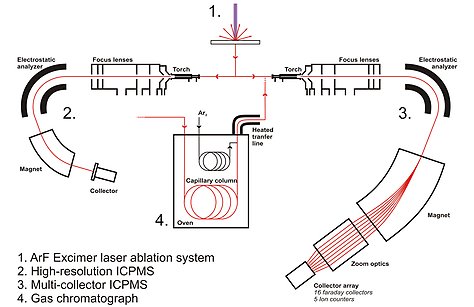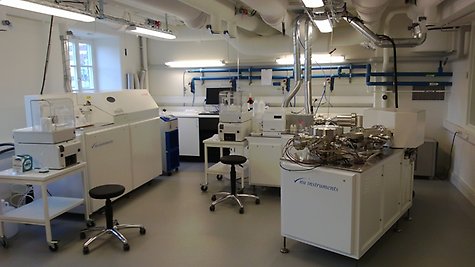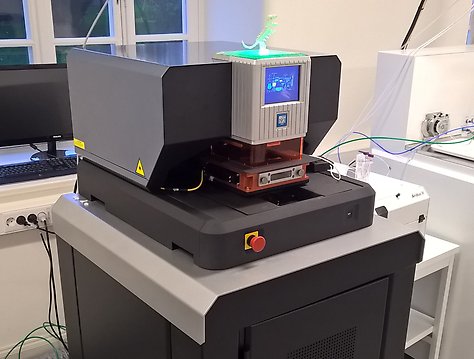Instrumentation
Instrumentation and analytical methods offered by the Vegacenter for microanalysis
The Vegacenter is built around two inductively coupled plasma mass spectrometers (ICP-MS) connected to a laser ablation (LA) system for microsampling. In addition, the facility is equipped with a gas chromatograph for compound-specific isotope analysis (CSIA).
A schematic overview of the instrument set-up is shown below.
Inductively Coupled Plasma Mass Spectro-metry (ICP-MS)
The Vegacenter is currently equipped with a Nu Plasma II high-resolution multi-collector ICP-MS and an AttoM high-resolution single collector ICP-MS, both by Nu Instruments Ltd. The Nu Plasma II is fitted with 16 Faraday cups and 5 ion counters allowing high-precision isotope analysis. The Nu Attom is fitted with one ion counter and one Faraday cup suitable for isotope and trace-element analysis.
Both instruments allow the analysis of either aspirated solutions or aerosols produced by laser ablation of solid materials.
Laser Ablation ICP-MS
The newest addition to the Vegacenter laboratory is the ESI New Wave Research NWR193UC laser ablation system. The core of the instrument comprises a Coherent ExciStar XS ArF Excimer laser (UV, 193 nm wavelength). The laser can be focused to spot sizes of 2-150 micron, enabling flexible micro-sampling of solid materials. The system is equipped with a TwoVol2 ablation cell, which allows mounting of samples of various shapes and sizes. A small cyclonic cup ensures efficient aerosol transport and washout. Mounted samples are imaged in real time using a built-in optical train with crossed-polarized, reflected light and coaxial light capabilities.
The laser ablation system can be connected to either of the two mass spectrometers, or to both simultaneously in a split-stream set-up. The connection to both mass spectrometers will allow simultaneous trace-element and isotope analysis on ablated aerosols. Examples of applications are U-Pb dating and Hf isotopes in zircon, U-Th-Pb dating and REE,Y in monazite, etc.
Compound-Specific Isotope Analysis (CSIA)
The Vegacenter is equipped with an Agilent 7890B Gas Chromatograph (GC), which can be used for Compound-Specific Isotope Analysis. The characterisation of isotope compositions of individual chemical compounds is experiencing a strong growth in environmental sciences and geosciences. A common application is isotopic characterization of carbon and hydrogen isotopes of individual compounds that can be used to quantitatively assess degradation processes of organic contaminants in the environment.
More recent advances in CSIA comprise determination of stable isotope ratios of halogens such as chlorine and bromine, in halogenated organic substances for quantitative source apportionment as well as degradation studies. The analytical challenges require a versatile system that includes both a method for separation of the compound in question followed by a method for accurate determination of the isotope ratio of the halogen.
Analytical methods
The Vegacenter offers a wide range of analytical methods and the number of applications will increase with ongoing method development. Currently established analytical procedures include:
Solution multi-collector ICP-MS:
- Si, S, Fe, Sr, Nd, Hf, Pb isotopes
Solution single collector ICP-MS:
- Trace-elements
- Single-particle ICP-MS (gold)
Laser ablation single collector ICP-MS:
- Trace-elements in silicates and phosphates
- U-Pb zircon
- U-Th-Pb monazite
- REE in garnet/apatite/accessory minerals
- Trace-elements in carbonates
- LA single-particle ICP-MS (gold)
- Trace-element mapping (e.g. garnet, soil)
Laser ablation multi collector ICP-MS:
- U(-Th)-Pb geochronology of accessory minerals
- Hf isotopes in zircon
- Pb isotopes in feldspar, sulfide, silver, pottery
- Sr isotopes in (hydroxyl/fluor-)apatite, calcite, plagioclase
- B isotopes in mica
Other analytical methods may exist or can be developed collaboratively - please submit your enquiry to Chris Mark.





